Anachronism
Anachronism means an error in chronology, something like attributing to an era or a character ideas and feelings that are from another era, or in representing, in works of art, customs and objects of an era to which they do not belong, finally, an attitude or fact that is not maintaining its time.

Well, that's precisely what this game brings us, Anachronism! Heroes, famous warriors in their times can finally meet thanks to Anachronism, they will coexist and fight until only one resists.
Scenario
We are in an arena where on one side is a warrior with all their skills along with 4 more "supports", namely: weapon, something to inspire them, allies (including cavalry), shield and armor.
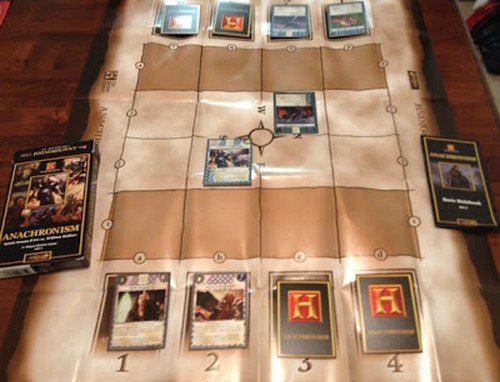
On the other side, another warrior, in turn, with their technical peculiarities and their 4 “supports”. Two characters from totally different eras, with different technologies, face off in this fast, but deadly strategic game, which with only 5 cards on each side, manages to have so much depth.
Honestly, it's a "tuned" Summoner Wars with strong chess strategic appeal.
Anachronism, the card game
It is a card game by designers Michael A. Brown and Stephen McLaughlin, for 2 to 4 players (better in 2 players) lasting an incredible 5 minutes. That's right, 5 minutes.
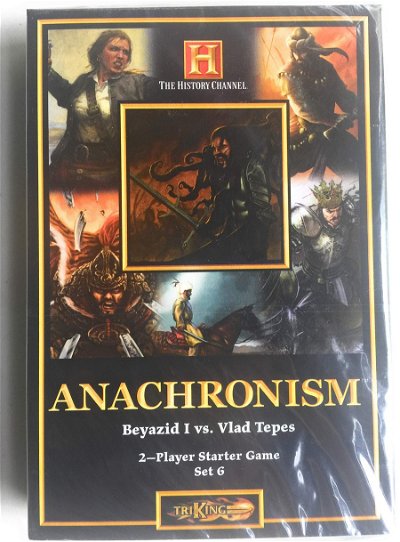
It had 10 card sets released from 2005 to 2008 with an average of 100 cards per set, which included warriors, armor, weapons, inspiration and special cards (shields and allies). That is, more than 1000 well distributed cards, bringing stories from more than 30 different cultures.
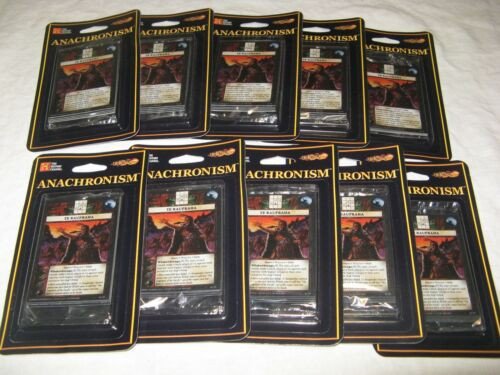
Anachronism received 2 awards in 2005 in the year of its release: the Best Translation and the Origin Awards as the Best Trading Card Game of the Year.
Components
About the components, the cards are of excellent quality, really thick and rigid.
Two 6-sided dices comes with the Basic Kit
The board is made of paper, which I didn't like—but you can't have everything in this life. The box is small, its cost is low, it wouldn't even be possible to put a board the size of the arena that the cards use. The way out was to make a paper Arena in the best “Summoner Wars” 1st edition style.
Card Anatomy
An important thing in Anachronism is that you know the potential and types of the cards. Basically, there are 2 types of cards: the Warriors and the Support cards.
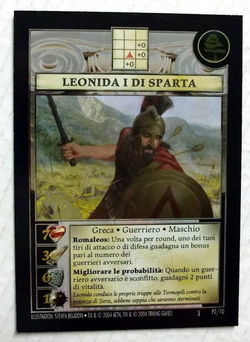
Above the card and in the center we have the Attack Grid, that is, the red arrow where your Warrior is, as well as the values where they can attack. The right side of the Attack Grid shows the Warrior's elemental alignment (wind, water, earth, fire, metal, wood, and ether). Below the Attack Grid is the Warrior's name and then (below) their image.
The 4 values in the lower-left corner are respectively (from top to bottom): health, number of actions, experience and damage. The table on the left side of the values brings the characteristics of the Warrior, their abilities, and a text with specific curiosities of that culture.
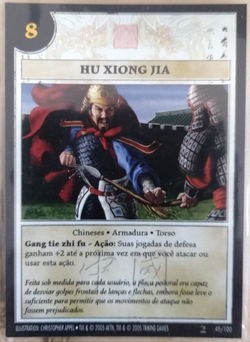
The anatomy of a Support, in this case, an Armor, is simpler to analyze and understand.
In the upper-left corner you have the Initiative of the card, just below the center, the name of the Armor, and then (below), its image. The table below the image brings the characteristics, their skills and a text with specific curiosities of the culture in which.
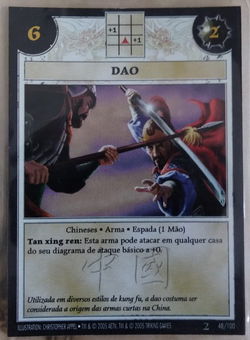
The Weapon Card has some peculiarities, it has the Initiative in the upper-left corner, the Attack Grid in the center and the Damage Value on the right. Otherwise, it follows like the other cards described above.
Game Setup and Initial Strategies
Talking about the game's Setup is necessary, as the initial strategies are already there.
“Everyone can see the tactics of my conquests, but no one can discern the strategy that generated the victories.”
- Sun Tzu
The luck factor, that is, the use of dice, takes place at the beginning, where the opponents roll 2 dice, add their respective values and whoever has the lowest value starts placing their Warrior on the Grid. The strategy starts there because your Warrior's Attack Grid will influence where you place them in the Initial Round, and later, already trying to defend themselves, your opponent will position their Warrior, obviously now privileging defense, as they already know their opponent's Attack Grid.
Now it starts to fry the brain. Remember I said there are 4 Support cards? Well, now it's time to secretly place them, face down, in each of the 4 slots behind the Start Row.
But what does that impact the game? Great question, as this interferes with everything in the game.
Turns
The game has 4 turns. Simultaneously on each turn, the players reveal their cards, on the 1st turn, they reveal card 1, they check the initiatives, whoever has the highest value starts, then the Warrior performs the number of actions they have, moving orthogonally (horizontally and vertically), attacking, defending, changing direction, etc.
For attacking, remember the Attack Grid. Well, the Warrior can only attack if the opponent is in any of the places marked with values in their Attack Grid, that is, it is necessary to position well before attacking to make the best attack possible.
Once this is done, the dice are rolled, bonuses are applied, the defender makes the same roll with the dice and applies any bonuses, and the highest final value wins. If there is a tie, the one with the highest Experience wins.
So, is this game all about moving and attacking? Of course not - You need to be strategically positioned to hit your opponent and managing the amount of your actions to be able to get out of sight of the opponent's Attack Grid. Thought it was simple, didn't you?
But what about the Weapon Attack Grid? Well, if you decide to use your weapon instead of the Warrior's basic attack, start to respect the Weapon Grid, another position totally different from the Warrior's, as it can be a ranged or melee weapon, in short, your position will be totally different if you are armed.
See how 5 supposedly harmless cards can give you numerous possibilities?
Strategic Tips
Let's now discuss some strategic tips in Anachronism, which go beyond coldly calculated moves.
I already gave the hint about the Setup of the game, but let's analyze it better and more carefully. Just like in chess, occupying the center of the board gives you more freedom of movement, but it's not that simple. Before that, it's necessary to analyze your Warrior's Attack Grid, as they can be stronger on one side, not necessarily balanced when attacking left or right. Think of the Arena, of dominating it, but of privileging your Warrior's type of attack.
Also analyze your Weapon's Attack Grid, it will dictate the best position your Warrior should be in relation to the opponent. Have the 2 Grids well mastered in your head.
“The ability to achieve victory by changing and adapting according to the enemy is called genius.”
- Sun Tzu
Still in the setup, placing the 4 cards face down is also a task that requires a lot of strategy, let's see: as only 1 is released per turn, you have to choose what you want for Support first: an inspiration, a weapon, an armor, a support — in short, you can do the well-known “combo” with the cards, they are interdependent and very efficient if well positioned.
Finally, think about spending the least number of actions on positioning, attacking, and saving actions to position yourself defensively. Know that attacking the entire turn may not be the best choice, but retreating to attack heavily on the next turn.
“Those who know when to fight and when to wait triumph.”
- Sun Tzu
Keep in mind that your weapon can only be used in 1 action of your turn, that is, you cannot attack with your weapon 2 times in the same turn, unless a Support card says otherwise. That is, you only attack 1 or more times with your Warrior's basic attack, with your weapon, only 1 time in the turn. Therefore, you have to position yourself in a way that best meets your 2 Attack Grids, yours and your weapon's.
End of Game
The game ends if the opponent's life points are reduced to zero before or until the 4th turn. If the 2 players are still alive, a 5th turn is played, and whoever has the most life wins.
If there is a tie, whoever has the most experience wins, and if the tie persists, players are tied.
Teaching Tips for Anachronism
Anachronism can also be considered a powerful educational tool, being a full plate for educators, students and parents in teaching History. As stated earlier, all of them have a text explaining a bit of the culture of that Warrior, that weapon, armor, inspiration or supporters, which makes reading them a History class.
It's worth, and I recommend, a search on the internet about your Warrior's life — you'll be in for many surprises when you learn about their history, achievements, and even the strategies used to win. You learn by playing.
It must be considered that calculations are also used in combats, and at least 2 basic operations will be exercised: addition and subtraction, which will allow children to develop these skills.
Speaking of skills, Anachronism also works on spatial location, as it is necessary to choose the best position for attacking and defending your Warrior, so the use of spatial location and strategy is combined.
There are only benefits for this simple game to play, to explain, but very deep in the strategy and in its teachings.
In time, Sun Tzu is present in one of the Warriors kits!
I recommend definitely Anachronism in your collection.









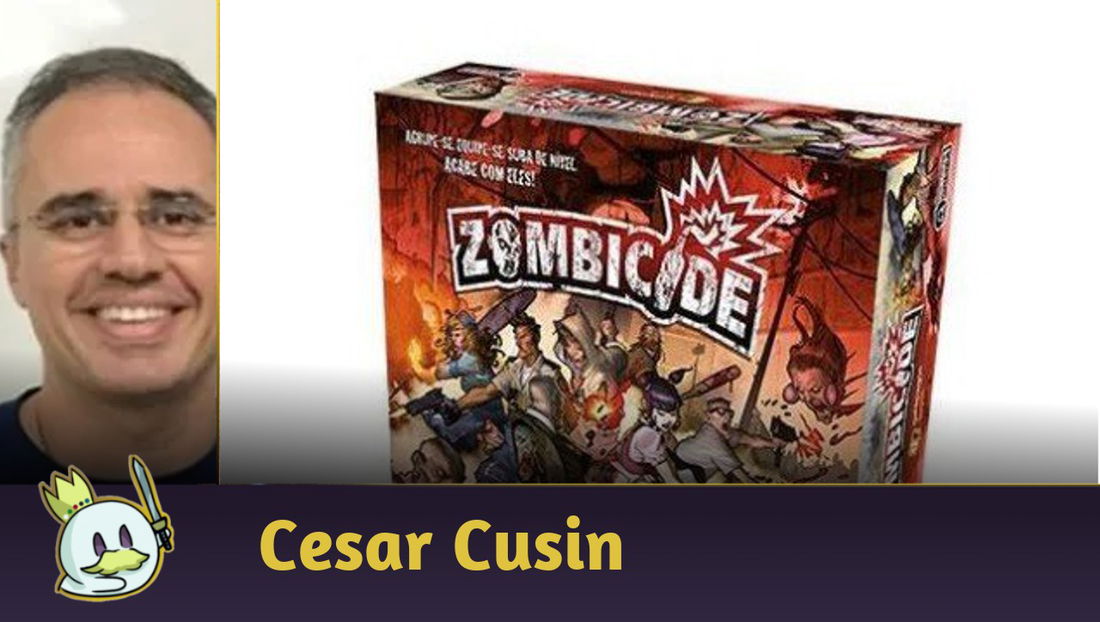




— Comentários 0
, Reações 1
Seja o primeiro a comentar